Ultra-Sensitive Refractive Index Sensing Based on Quasi-BICs in All-Dielectric Nanorod Array
Abstract
1. Introduction
2. Structure and Theory
3. Results and Discussion
4. Conclusions
Author Contributions
Funding
Institutional Review Board Statement
Informed Consent Statement
Data Availability Statement
Conflicts of Interest
References
- Kumar, S.; Singh, R. Recent optical sensing technologies for the detection of various biomolecules: Review. Opt. Laser Technol. 2021, 134, 106620. [Google Scholar] [CrossRef]
- Moreno, Y.; Song, G.; Xing, Z.; Sun, Y.; Yan, Z. Hybrid tilted fiber gratings-based surface plasmon resonance sensor and its application for hemoglobin detection. Chin. Opt. Lett. 2020, 18, 100601. [Google Scholar] [CrossRef]
- Sen, S.; Ahmed, K. Design of terahertz spectroscopy based optical sensor for chemical detection. SN Appl. Sci. 2019, 1, 1215. [Google Scholar] [CrossRef]
- Chocarro-Ruiz, B.; Fernandez-Gavela, A.; Herranz, S.; Lechuga, L. Nanophotonic label-free biosensors for environmental monitoring. Curr. Opin. Biotechnol. 2017, 45, 175–183. [Google Scholar] [CrossRef] [PubMed]
- Wang, X.; Deng, H.; Yuan, L. High sensitivity cascaded helicalcore fiber SPR sensors. Chin. Opt. Lett. 2021, 19, 091201. [Google Scholar] [CrossRef]
- Anker, J.; Hall, W.; Lyandres, O.; Shah, N.; Zhao, J.; Van Duyne, R. Biosensing with plasmonic nanosensors. Nat. Mater. 2008, 7, 442–453. [Google Scholar] [CrossRef] [PubMed]
- Monticone, F.; Alu, A. Metamaterial, plasmonic and nanophotonic devices. Rep. Prog. Phys. 2017, 80, 036401. [Google Scholar] [CrossRef] [PubMed]
- Wang, J.; Du, J. Plasmonic and Dielectric Metasurfaces: Design, Fabrication and Applications. Appl. Sci. 2016, 6, 239. [Google Scholar] [CrossRef]
- Tseng, M.; Fang, X.; Savinov, V.; Wu, P.; Ou, J.; Zheludev, N.; Tsai, D. Coherent selection of invisible high-order electromagnetic excitations. Sci. Rep. 2017, 7, 44488. [Google Scholar] [CrossRef]
- Yang, Y.; Kravchenko, I.; Briggs, D.; Valentine, J. All-dielectric metasurface analogue of electromagnetically induced transparency. Nat. Commun. 2014, 5, 5753. [Google Scholar] [CrossRef]
- Regmi, R.; Berthelot, J.; Winkler, P.; Mivelle, M.; Proust, J.; Bedu, F.; Ozerov, I.; Begou, T.; Lumeau, J.; Rigneault, H.; et al. All-Dielectric Silicon Nanogap Antennas To Enhance the Fluorescence of Single Molecules. Nano Lett. 2016, 16, 5143–5151. [Google Scholar] [CrossRef]
- Bontempi, N.; Chong, K.; Orton, H.; Staude, I.; Choi, D.; Alessandri, I.; Kivshar, Y.; Neshev, D. Highly sensitive biosensors based on all-dielectric nanoresonators. Nanoscale 2017, 9, 4972–4980. [Google Scholar] [CrossRef] [PubMed]
- Tseng, M.; Jahani, A.; Leitis, A.; Altug, H. Dielectric Metasurfaces Enabling Advanced Optical Biosensors. ACS Photonics 2018, 8, 47–60. [Google Scholar] [CrossRef]
- Huo, Y.; Zhang, X.; Yan, M.; Sun, K.; Jiang, S.; Ning, T.; Zhao, L. Highly-sensitive sensor based on toroidal dipole governed by bound state in the continuum in dielectric non-coaxial core-shell cylinder. Opt. Express 2022, 30, 19030–19041. [Google Scholar] [CrossRef] [PubMed]
- Friedrich, H.; Wintgen, D. Physical realization of bound states in the continuum. Phys. Rev. A 1985, 31, 3964–3966. [Google Scholar] [CrossRef]
- Friedrich, H.; Wintgen, D. Interfering resonances and bound states in the continuum. Phys. Rev. A 1985, 32, 3231–3242. [Google Scholar] [CrossRef] [PubMed]
- Bulgakov, E.; Sadreev, A. Bound states in the continuum in photonic waveguides inspired by defects. Phys. Rev. B 2008, 78, 075105. [Google Scholar] [CrossRef]
- Plotnik, Y.; Peleg, O.; Dreisow, F.; Heinrich, M.; Nolte, S.; Szameit, A.; Segev, M. Experimental Observation of Optical Bound States in the Continuum. Phys. Rev. Lett. 2011, 107, 183901. [Google Scholar] [CrossRef] [PubMed]
- Xiao, S.; Qin, M.; Duan, J.; Wu, F.; Liu, T. Polarization-controlled dynamically switchable high-harmonic generation from all-dielectric metasurfaces governed by dual bound states in the continuum. Phy. Rev. B 2022, 105, 195440. [Google Scholar] [CrossRef]
- Liu, D.; Yu, X.; Wu, F.; Du, W.; Chen, L.; Liu, F.; Kuwahara, M.; Ono, S. Terahertz asymmetric metallic hole arrays with polarization-independent quasi-bound states in the continuum for membrane sensing. Opt. Express 2023, 31, 23608–23620. [Google Scholar] [CrossRef]
- Ning, T.; Li, X.; Zhao, Y.; Yin, L.; Huo, Y.; Zhao, L.; Yue, Q. Giant enhancement of harmonic generation in all-dielectric resonant waveguide gratings of quasi-bound states in the continuum. Opt. Express 2020, 28, 34024–34034. [Google Scholar] [CrossRef] [PubMed]
- Koshelev, K.; Favraud, G.; Bogdanov, A.; Kivshar, Y.; Fratalocchi, A. Nonradiating photonics with resonant dielectric nanostructures. Nanophotonics 2019, 8, 725–745. [Google Scholar] [CrossRef]
- Wu, F.; Wu, J.; Guo, Z.; Jiang, H.; Sun, Y.; Li, Y.; Ren, J.; Chen, H. Giant Enhancement of the Goos-Hänchen Shift Assisted by Quasibound States in the Continuum. Phys. Rev. Appl. 2019, 12, 014028. [Google Scholar] [CrossRef]
- Li, W.; Liu, Y.; Ling, L.; Sheng, Z.; Cheng, S.; Yi, Z.; Wu, P.; Zeng, Q.; Tang, B.; Ahmad, S. The tunable absorber films of grating structure of AlCuFe quasicrystal with high Q and refractive index sensitivity. Surf. Interfaces 2024, 48, 104248. [Google Scholar] [CrossRef]
- Li, W.; Liu, M.; Cheng, S.; Zhang, H.; Yang, W.; Zao, Y.; Zeng, Q.; Tang, B.; Ahmad, S.; Sun, T. Polarization independent tunable bandwidth absorber based on single-layer graphene. Diam. Relat. Mater. 2024, 142, 110793. [Google Scholar] [CrossRef]
- Li, W.; Xu, F.; Cheng, S.; Yang, W.; Liu, B.; Liu, M.; Yi, Z.; Tang, B.; Chen, J.; Sun, T. Six-band rotationally symmetric tunable absorption film based on AlCuFe quasicrystals. Opt. Laser Technol. 2024, 169, 110186. [Google Scholar] [CrossRef]
- Li, Z.; Xiang, Y.; Xu, S.; Dai, X. Ultrasensitive terahertz sensing in all-dielectric asymmetric metasurfaces based on quasi-BIC. J. Opt. Soc. Am. B 2022, 39, 286–291. [Google Scholar] [CrossRef]
- Liu, W.; Yan, B.; Jiang, X. High performance sensor based on phase difference induced quasi-BIC and Fermi energy. Opt. Lett. 2023, 48, 6012–6014. [Google Scholar] [CrossRef] [PubMed]
- Samadi, M.; Abshari, F.; Algorri, J.; Varona, P.; Cobo, L.; Higuera, J.; Prna, J.; Zografopoulos, D.; Dell’Olio, F. All-Dielectric Metasurface Based on Complementary Split-Ring Resonators for Refractive Index Sensing. Photonics 2022, 9, 130. [Google Scholar] [CrossRef]
- Yu, S.; Wang, Y.; Gao, Z.; Li, H.; Song, S.; Yu, J.; Zhao, T. Dual-band polarization-insensitive toroidal dipole quasi-bound states in the continuum in a permittivity-asymmetric all-dielectric meta-surface. Opt. Express 2022, 30, 4084–4095. [Google Scholar] [CrossRef]
- Wang, T.; Liu, S.; Zhang, J.; Xu, L.; Yang, M.; Ma, D.; Jiang, S.; Jiao, Q.; Tan, X. Dual high-Q Fano resonances metasurfaces excited by asymmetric dielectric rods for refractive index sensing. Nanophotonics 2024, 13, 463–475. [Google Scholar] [CrossRef]
- Chen, H.; Fan, X.; Fang, W.; Cao, S.; Sun, Q.; Wang, D.; Niu, H.; Li, C.; Wei, X.; Bai, C.; et al. Investigation of Multiple High Quality-Factor Fano Resonances in Asymmetric Nanopillar Arrays for Optical Sensing. Photonics 2024, 11, 68. [Google Scholar] [CrossRef]
- Cao, S.; Fan, X.; Fang, W.; Chen, H.; Bai, C.; Tong, C. A high-performance multi-wavelength optical switch based on multiple Fano resonances in an all-dielectric metastructure. Optoelectron. Lett. 2024, 20, 193–199. [Google Scholar] [CrossRef]
- Sun, Q.; Fan, X.; Fang, W.; Chen, H.; Wang, D.; Cao, S.; Niu, H.; Li, C.; Bai, C.; Wei, X. High sensitivity multiple Fano resonances sensing in all-dielectric hollow nanocylinder dimer metastructure. Opt. Quant. Electron. 2024, 56, 337. [Google Scholar] [CrossRef]
- Chen, H.; Fan, X.; Fang, W.; Zhang, B.; Cao, S.; Sun, Q.; Wang, D.; Niu, H.; Li, C.; Wei, X.; et al. High-Q Fano resonances in all-dielectric metastructures for enhanced optical biosensing applications. Biomed. Opt. Express 2024, 15, 294–305. [Google Scholar] [CrossRef] [PubMed]
- Liang, S.; Xu, F.; Li, W.; Yang, W.; Cheng, S.; Yang, H.; Chen, J.; Yi, Z.; Jiang, P. Tunable smart mid infrared thermal control emitter based on phase change material VO2 thin film. Appl. Therm. Eng. 2023, 232, 121074. [Google Scholar] [CrossRef]
- Shangguan, Q.; Zhao, Y.; Song, Z.; Wang, J.; Yang, H.; Chen, J.; Liu, C.; Cheng, S.; Yang, W.; Yi, Z. High sensitivity active adjustable graphene absorber for refractive index sensing applications. Diam. Relat. Mater. 2022, 128, 109273. [Google Scholar] [CrossRef]
- Pierce, D.; Spicer, W. Electronic structure of amorphous Si from photoemission and optical studies. Phys. Rev. B 1972, 5, 3017–3029. [Google Scholar] [CrossRef]
- Zhao, X.; Zhang, X.; Zhu, X.; Shi, Y. Long-range surface plasmon resonance sensor based on the GK570/Ag coated hollow fiber with an asymmetric layer structure. Opt. Express 2019, 27, 9550–9560. [Google Scholar] [CrossRef]
- Zhao, C.; Huo, Y.; Liu, T.; Liao, Z.; Xu, C.; Zhang, T. All-dielectric metasurface with multiple Fano resonances supporting high-performance refractive index sensing. J. Opt. Soc. Am. B 2023, 41, 36. [Google Scholar] [CrossRef]
- Pu, M.; Song, M.; Yu, H.; Hu, C.; Wang, M.; Wu, X.; Luo, J.; Zhang, Z.; Luo, X. Fano resonance induced by mode coupling in all-dielectric nanorod array. Appl. Phys. Express 2014, 7, 032002. [Google Scholar] [CrossRef]
- Sun, W.; Liang, Z.; Shi, X.; Yang, F.; Dong, Y.; Dai, R.; Jia, Y.; Xin, W.; Hou, E.; Wu, Z. Potential of high Q dual band Mid-Infrared metasurfaces with Quasi-BIC for refractive index sensing. Opt. Laser Technol. 2024, 174, 110631. [Google Scholar] [CrossRef]
- Luo, M.; Zhou, Y.; Zhao, X.; Guo, Z.; Li, Y.; Wang, Q.; Liu, J.; Luo, W.; Shi, Y.; Liu, A.; et al. High-Sensitivity Optical Sensors Empowered by Quasi-Bound States in the Continuum in a Hybrid Metal–Dielectric Metasurface. ACS Nano 2024, 18, 6477–6486. [Google Scholar] [CrossRef]
- Lu, X.; Zheng, G.; Zhou, P. High performance refractive index sensor with stacked two-layer resonant waveguide gratings. Results Phys. 2019, 12, 759–765. [Google Scholar] [CrossRef]
- Shi, C.; Liu, X.; Hu, J.; Han, H.; Zhao, J. High performance optical sensor based on double compound symmetric gratings. Chin. Opt. Lett. 2022, 20, 021201. [Google Scholar] [CrossRef]
- Zhou, X.; Wang, Y.; Sun, Y.; Wang, F.; Yan, X.; Zhang, X.; Suzuki, T.; Ohishi, Y.; Cheng, T. High sensitivity and stability probe-type refractive index sensor based on an optical fiber metasurface. J. Opt. Soc. Am. B 2023, 40, 1945–1952. [Google Scholar] [CrossRef]
- Myers, T.; Tonkyn, R.; Danby, T.; Taubman, M.; Bernacki, B.; Birnbaum, J.; Sharpe, S.; Johnson, T. Accurate measurement of the optical constants n and k for a series of 57 inorganic and organic liquids for optical modeling and detection. Appl. Spectrosc. 2018, 72, 535–550. [Google Scholar] [CrossRef] [PubMed]
- Yoon, G.; Kim, I.; So, S.; Mun, J.; Kim, M.; Rho, J. Fabrication of three-dimensional suspended, interlayered and hierarchical nanostructures by accuracy-improved electron beam lithography overlay. Sci. Rep. 2017, 7, 6668. [Google Scholar] [CrossRef]
- Liu, Z.; Guo, T.; Tan, Q.; Hu, Z.; Sun, Y.; Fan, H.; Zhang, Z.; Jin, Y.; He, S. Phase Interrogation Sensor Based on All-Dielectric BIC Metasurface. Nano Lett. 2023, 23, 10441–10448. [Google Scholar] [CrossRef]
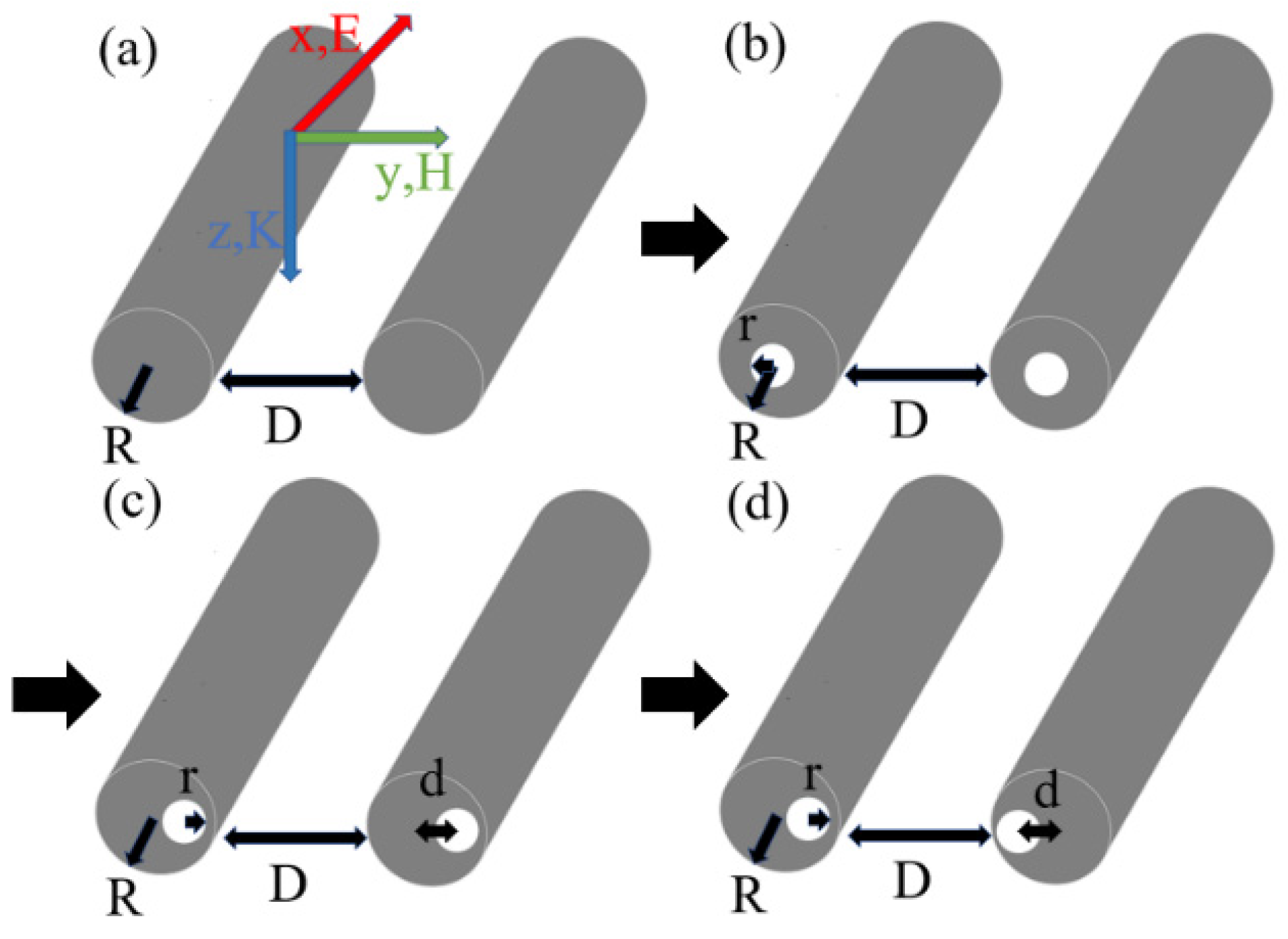
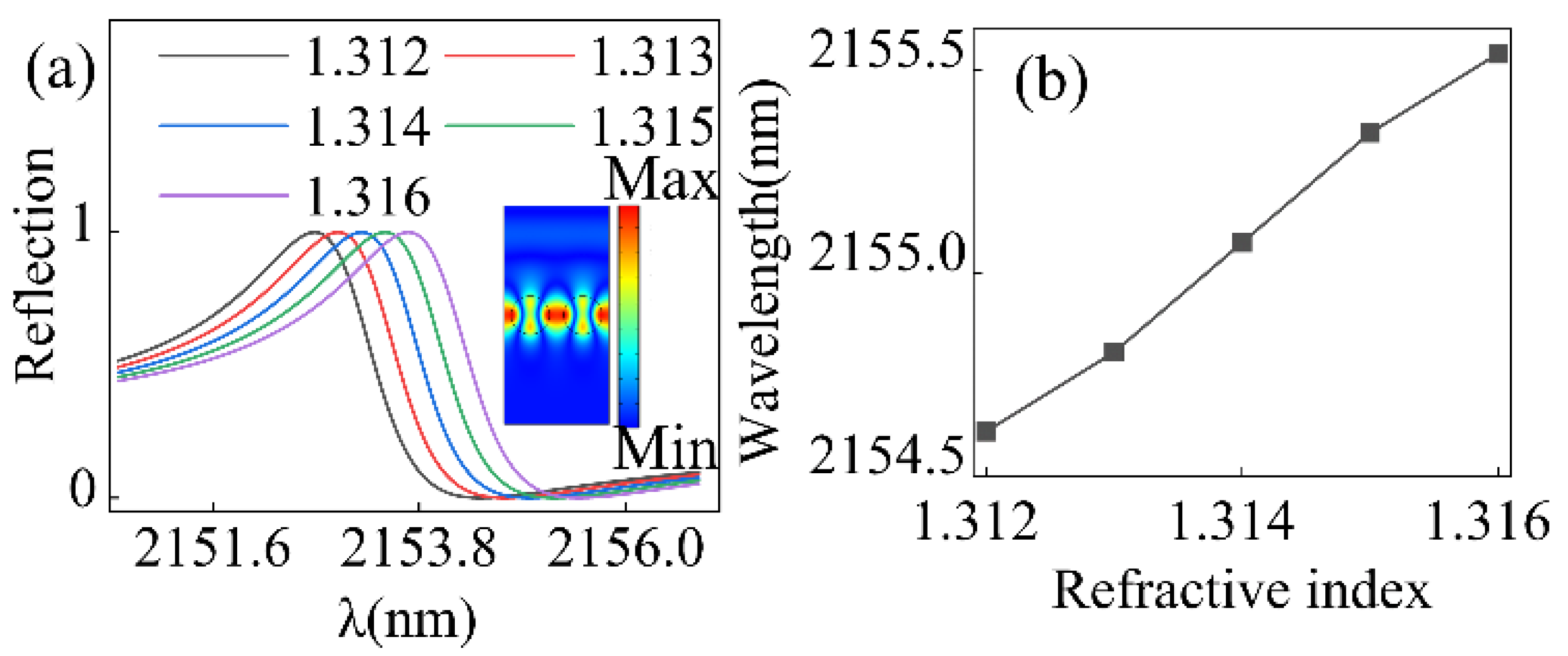
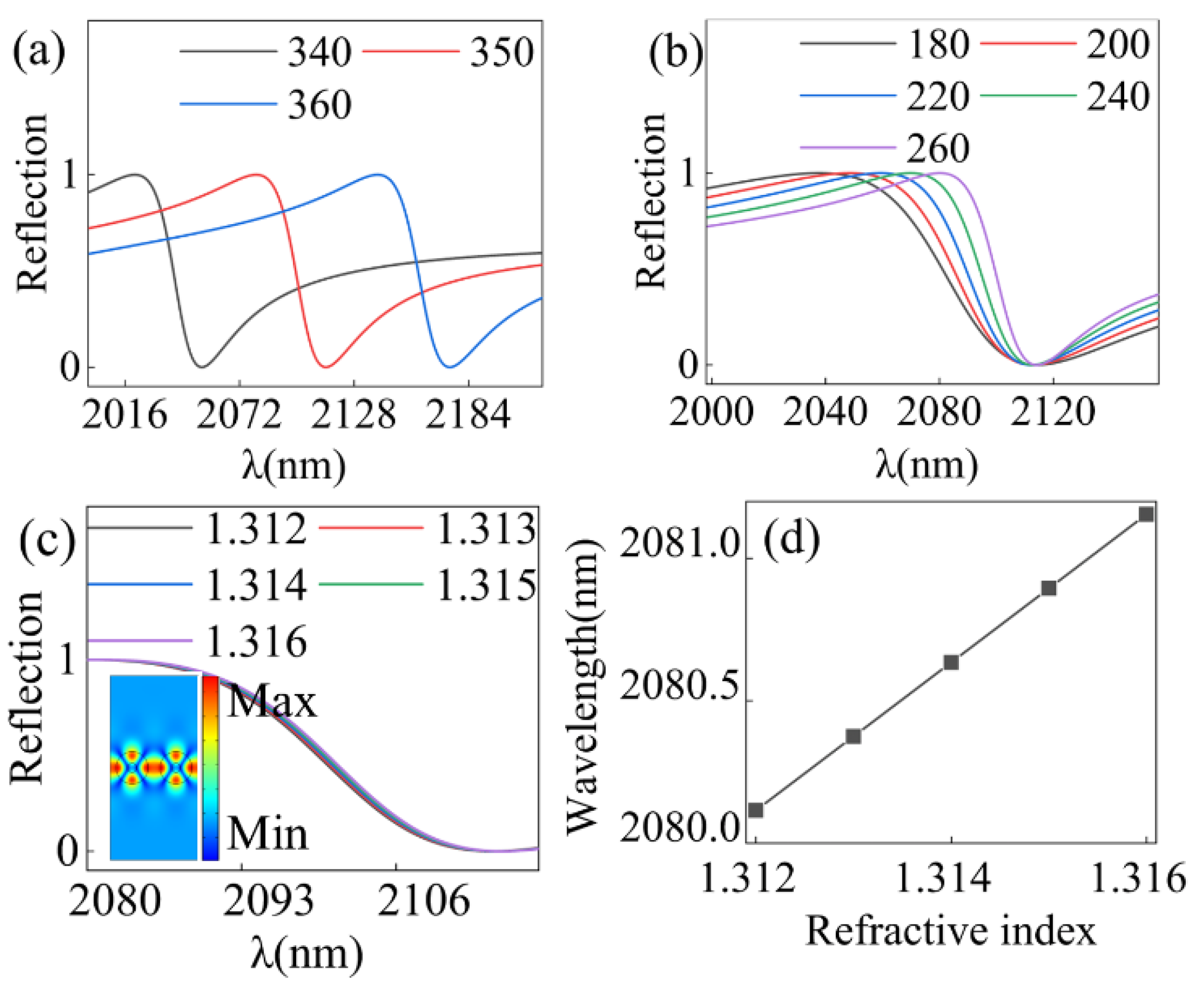
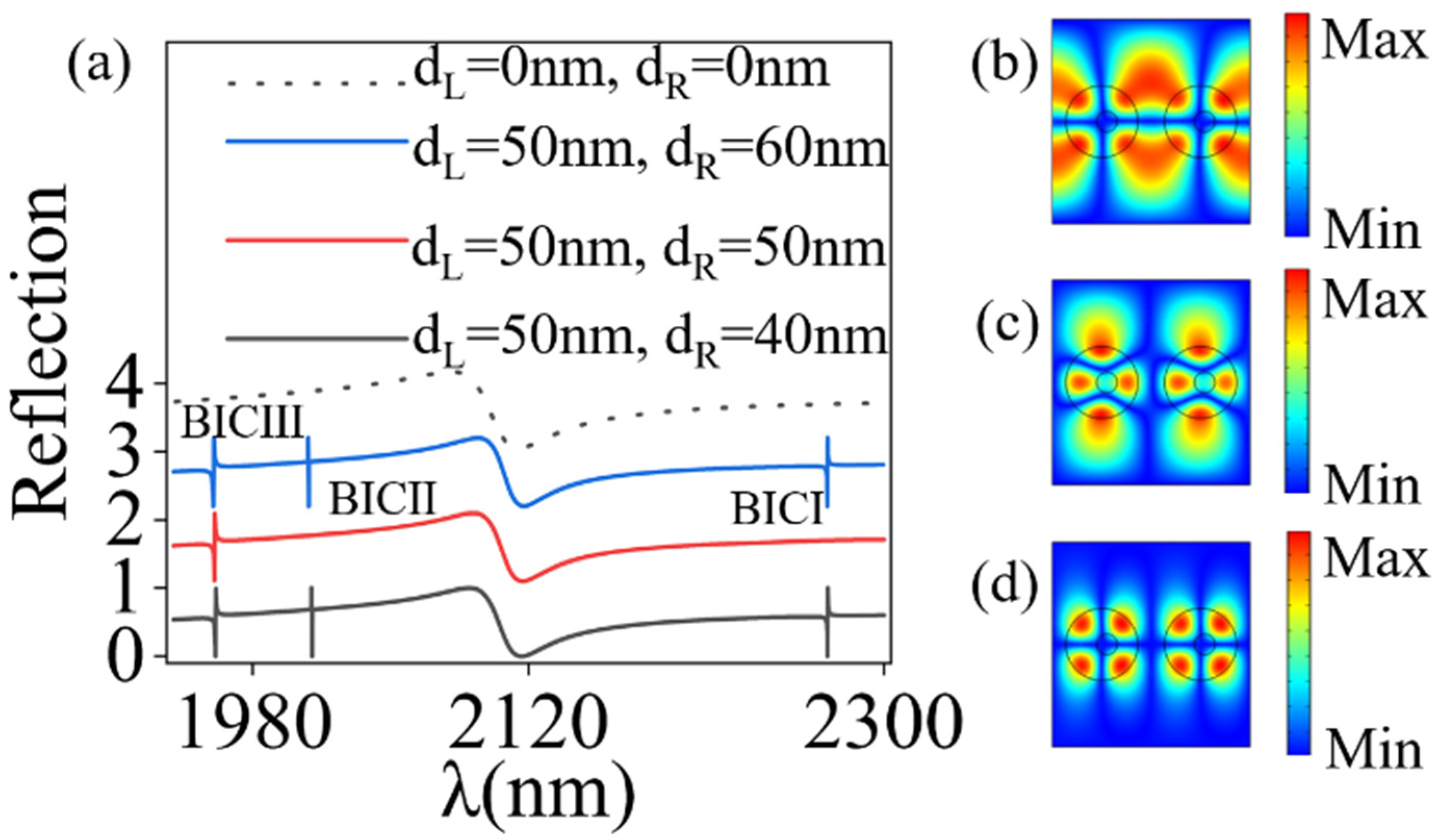
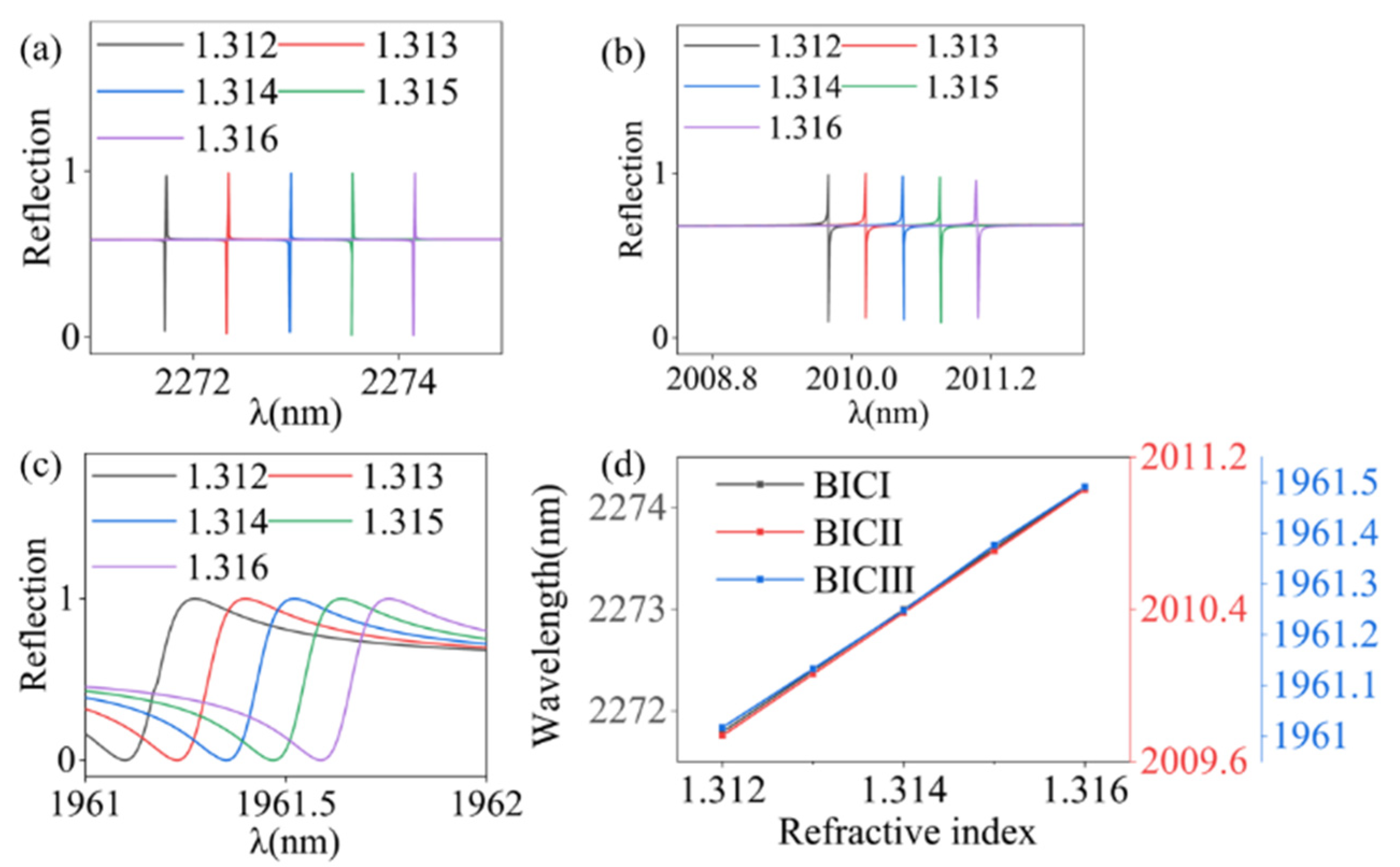

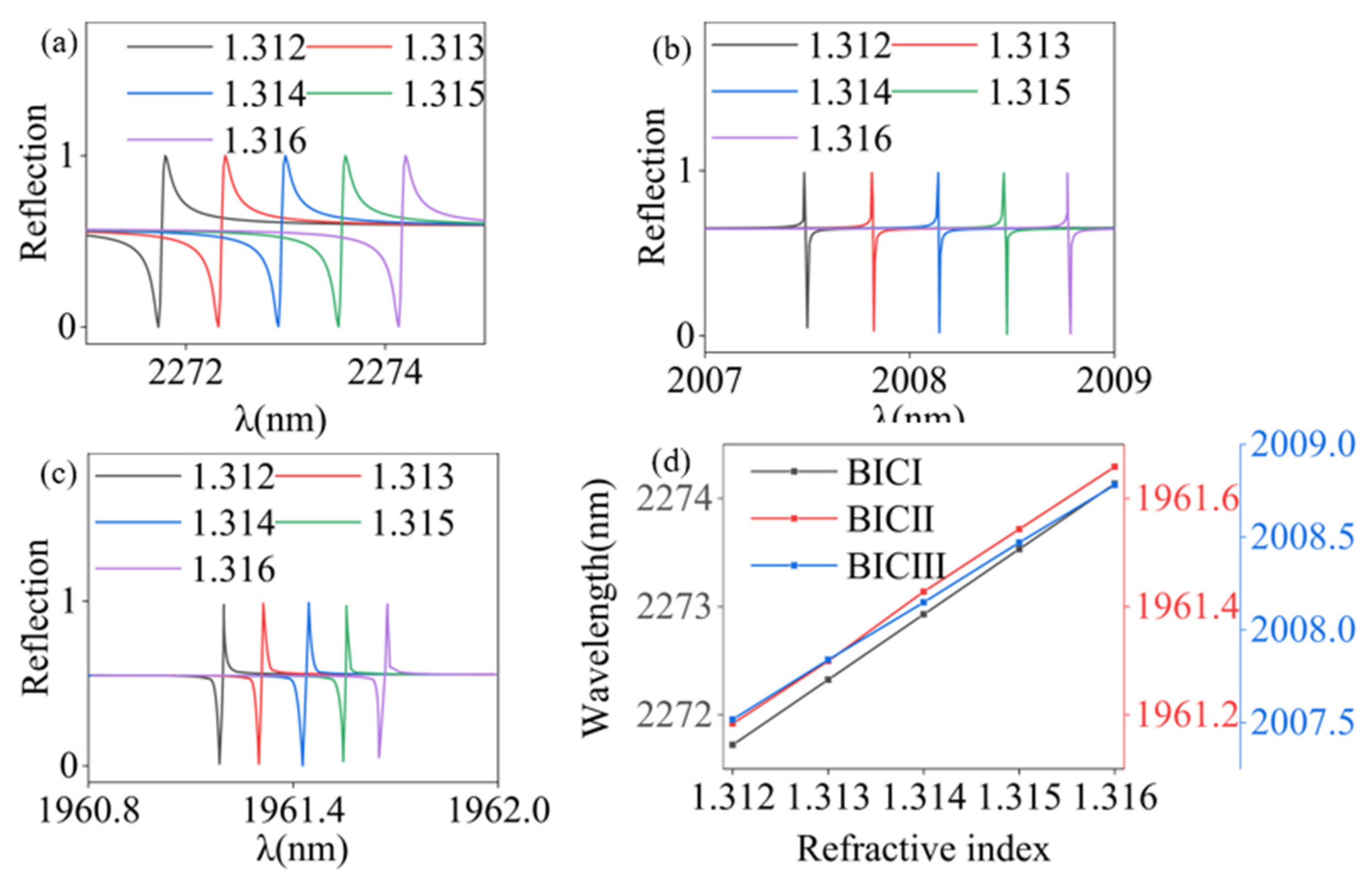
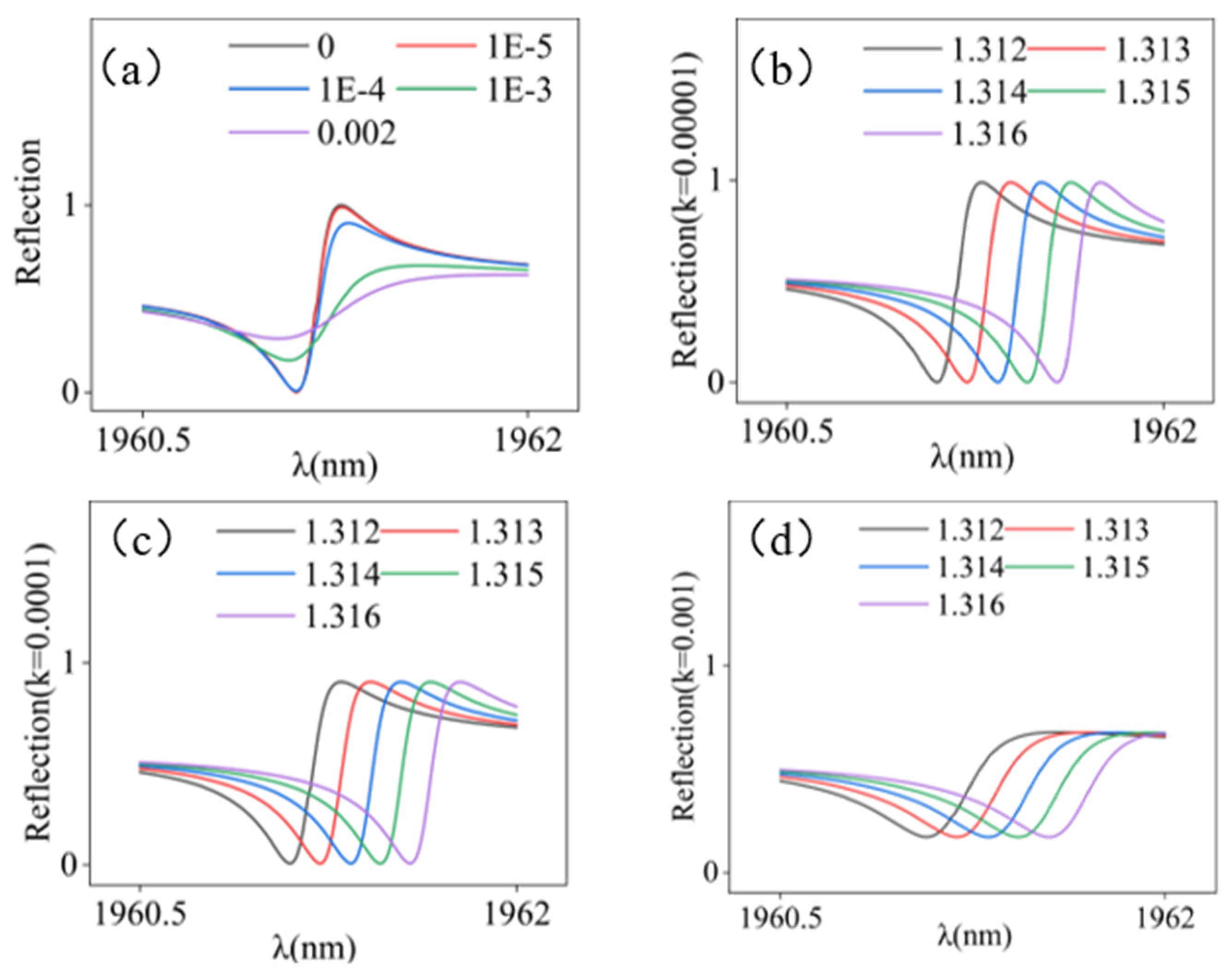
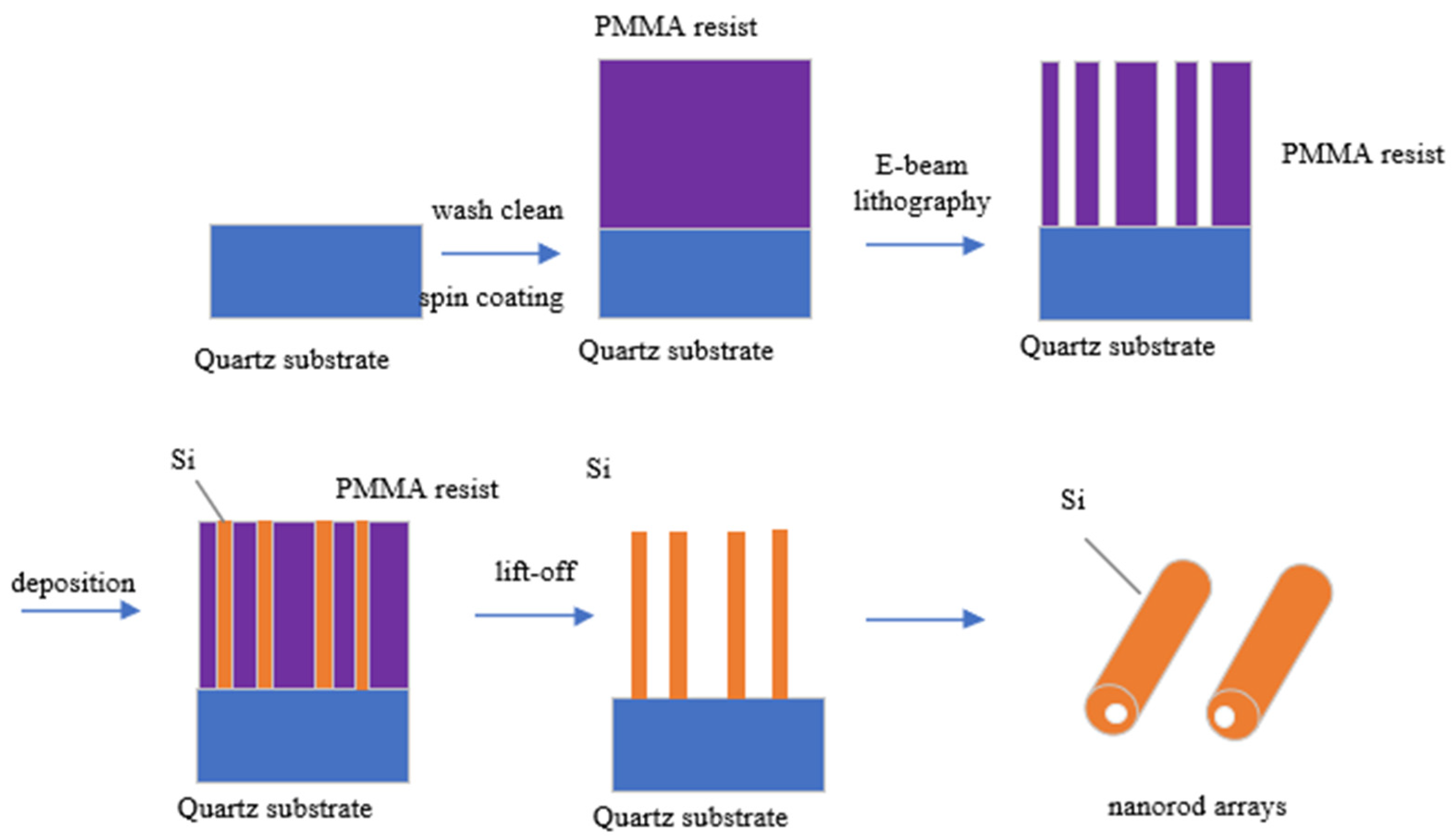
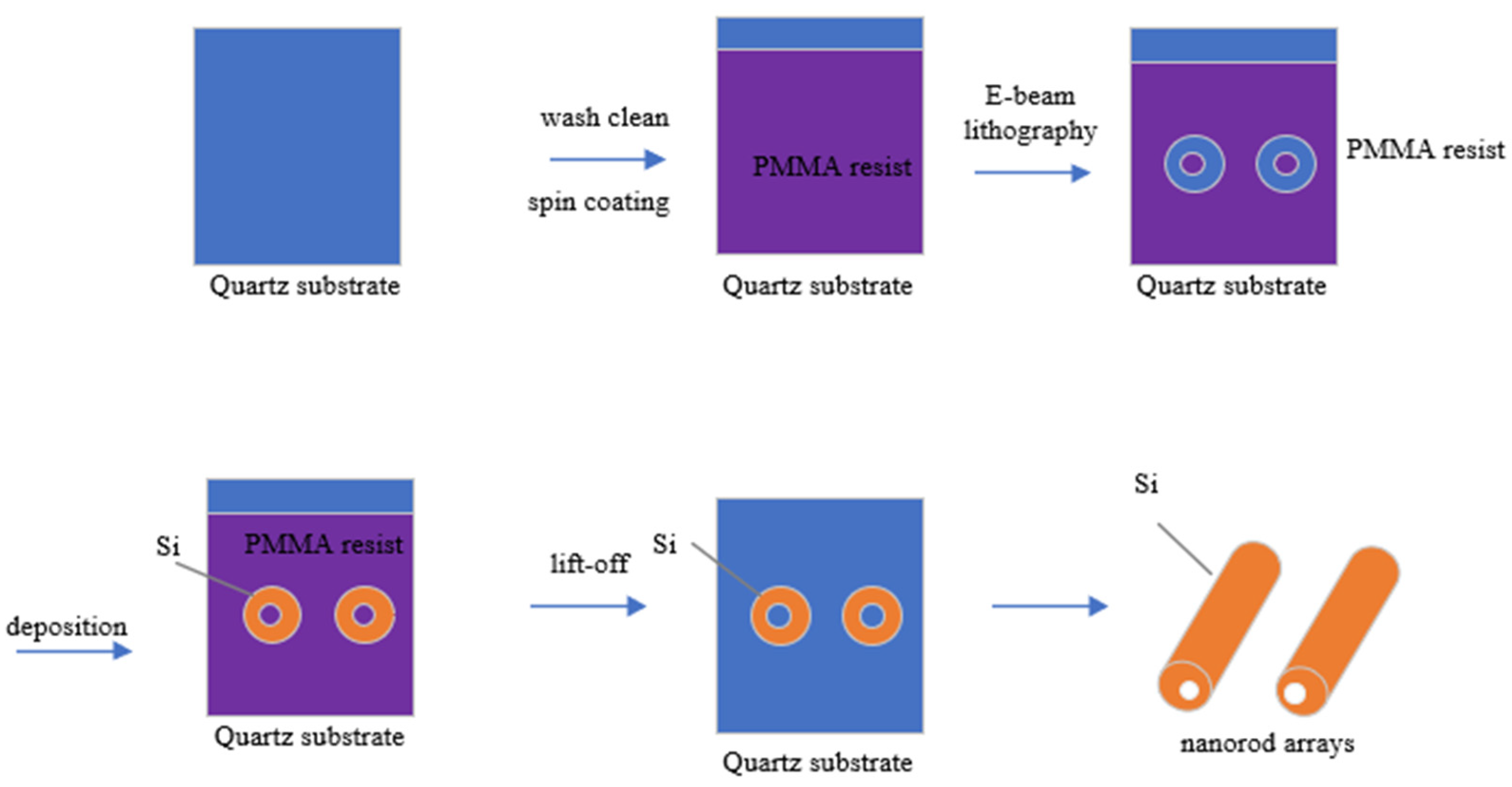
| Structure | Index Sensitivity (nm/RIU) | Wavelength (nm) | FOM | References |
|---|---|---|---|---|
| Non-coaxial core-shell cylinder nanostructure | 342 | 750–880 | 1295 | [14] |
| All-dielectric hollow nanocylinder dimer metastructure | 870 | 1000–1600 | 600 | [34] |
| Silicon triangular-hole nanodisk array | 248 | 1100–1500 | 3815 | [40] |
| Four elliptical nanodisks and a circular nanodisk | 2307 | 6000–7000 | 1792 | [42] |
| Optical sensor composed of a hybrid cylindrical tetramer metasurface (HCTM) | 497.2 | 600–950 | 266.3 | [43] |
| Stacked two-layer resonant waveguide gratings | 497.83 | —— | 551 | [44] |
| Double compound symmetric gratings | 472 | —— | 31,467 | [45] |
| Probe-type sensor based on an optical fiber metasurface | 1415 | 600–1600 | —— | [46] |
| Symmetric nanorod arrays with center hole | 602.9 | 1900–2300 | 34977 | This work |
Disclaimer/Publisher’s Note: The statements, opinions and data contained in all publications are solely those of the individual author(s) and contributor(s) and not of MDPI and/or the editor(s). MDPI and/or the editor(s) disclaim responsibility for any injury to people or property resulting from any ideas, methods, instructions or products referred to in the content. |
© 2024 by the authors. Licensee MDPI, Basel, Switzerland. This article is an open access article distributed under the terms and conditions of the Creative Commons Attribution (CC BY) license (https://creativecommons.org/licenses/by/4.0/).
Share and Cite
Zhao, Y.; Wu, Z.; Feng, Z.; Ning, T. Ultra-Sensitive Refractive Index Sensing Based on Quasi-BICs in All-Dielectric Nanorod Array. Photonics 2024, 11, 503. https://doi.org/10.3390/photonics11060503
Zhao Y, Wu Z, Feng Z, Ning T. Ultra-Sensitive Refractive Index Sensing Based on Quasi-BICs in All-Dielectric Nanorod Array. Photonics. 2024; 11(6):503. https://doi.org/10.3390/photonics11060503
Chicago/Turabian StyleZhao, Yuefeng, Zhenghua Wu, Zhihao Feng, and Tingyin Ning. 2024. "Ultra-Sensitive Refractive Index Sensing Based on Quasi-BICs in All-Dielectric Nanorod Array" Photonics 11, no. 6: 503. https://doi.org/10.3390/photonics11060503
APA StyleZhao, Y., Wu, Z., Feng, Z., & Ning, T. (2024). Ultra-Sensitive Refractive Index Sensing Based on Quasi-BICs in All-Dielectric Nanorod Array. Photonics, 11(6), 503. https://doi.org/10.3390/photonics11060503




